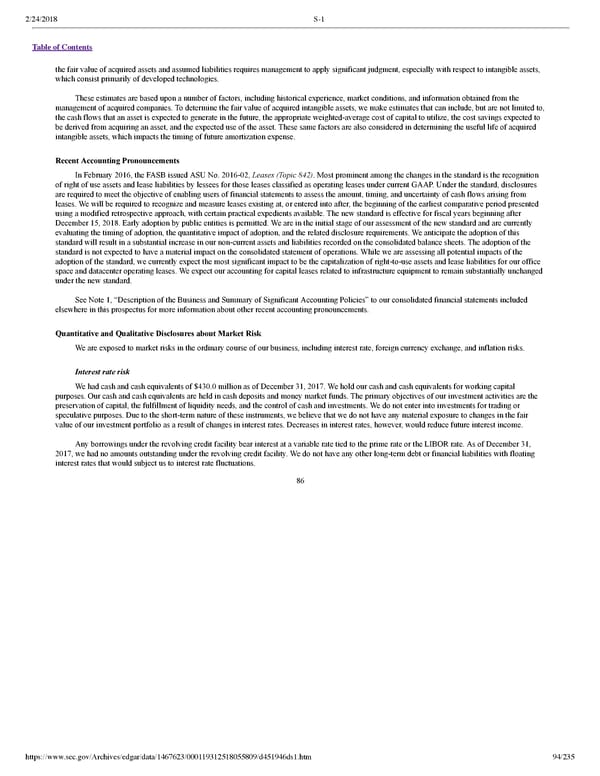2/24/2018 S-1 Table of Contents the fair value of acquired assets and assumed liabilities requires management to apply significant judgment, especially with respect to intangible assets, which consist primarily of developed technologies. These estimates are based upon a number of factors, including historical experience, market conditions, and information obtained from the management of acquired companies. To determine the fair value of acquired intangible assets, we make estimates that can include, but are not limited to, the cash flows that an asset is expected to generate in the future, the appropriate weightedaverage cost of capital to utilize, the cost savings expected to be derived from acquiring an asset, and the expected use of the asset. These same factors are also considered in determining the useful life of acquired intangible assets, which impacts the timing of future amortization expense. Recent Accounting Pronouncements In February 2016, the FASB issued ASU No. 201602, Leases (Topic 842). Most prominent among the changes in the standard is the recognition of right of use assets and lease liabilities by lessees for those leases classified as operating leases under current GAAP. Under the standard, disclosures are required to meet the objective of enabling users of financial statements to assess the amount, timing, and uncertainty of cash flows arising from leases. We will be required to recognize and measure leases existing at, or entered into after, the beginning of the earliest comparative period presented using a modified retrospective approach, with certain practical expedients available. The new standard is effective for fiscal years beginning after December 15, 2018. Early adoption by public entities is permitted. We are in the initial stage of our assessment of the new standard and are currently evaluating the timing of adoption, the quantitative impact of adoption, and the related disclosure requirements. We anticipate the adoption of this standard will result in a substantial increase in our noncurrent assets and liabilities recorded on the consolidated balance sheets. The adoption of the standard is not expected to have a material impact on the consolidated statement of operations. While we are assessing all potential impacts of the adoption of the standard, we currently expect the most significant impact to be the capitalization of righttouse assets and lease liabilities for our office space and datacenter operating leases. We expect our accounting for capital leases related to infrastructure equipment to remain substantially unchanged under the new standard. See Note 1, “Description of the Business and Summary of Significant Accounting Policies” to our consolidated financial statements included elsewhere in this prospectus for more information about other recent accounting pronouncements. Quantitative and Qualitative Disclosures about Market Risk We are exposed to market risks in the ordinary course of our business, including interest rate, foreign currency exchange, and inflation risks. Interest rate risk We had cash and cash equivalents of $430.0 million as of December 31, 2017. We hold our cash and cash equivalents for working capital purposes. Our cash and cash equivalents are held in cash deposits and money market funds. The primary objectives of our investment activities are the preservation of capital, the fulfillment of liquidity needs, and the control of cash and investments. We do not enter into investments for trading or speculative purposes. Due to the shortterm nature of these instruments, we believe that we do not have any material exposure to changes in the fair value of our investment portfolio as a result of changes in interest rates. Decreases in interest rates, however, would reduce future interest income. Any borrowings under the revolving credit facility bear interest at a variable rate tied to the prime rate or the LIBOR rate. As of December 31, 2017, we had no amounts outstanding under the revolving credit facility. We do not have any other longterm debt or financial liabilities with floating interest rates that would subject us to interest rate fluctuations. 86 https://www.sec.gov/Archives/edgar/data/1467623/000119312518055809/d451946ds1.htm 94/235
 Dropbox S-1 | Interactive Prospectus Page 93 Page 95
Dropbox S-1 | Interactive Prospectus Page 93 Page 95